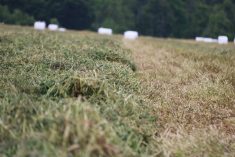Monsanto Canada is fighting what it says is “fear-based rhetoric floating around about farming practices and (weed) resistance in Canada.”
In a recent full-page advertisement in several farm newspapers, including the Manitoba Co-operator, Michiel De Jongh, Monsanto Canada’s president and general manager, said Monsanto should’ve addressed herbicide-resistant weeds sooner.
“When you began to battle herbicide resistance, we should have stood beside you,” De Jongh wrote. “Instead, fear spread. It’s time to trade fear for confidence.”
To that end De Jongh announced Monsanto will “take the leadership position on herbicide resistance and crop management,” which includes a new agronomy platform called Monsanto Crop Management Solutions.
Read Also

New ranking elevates Assiniboine College to national research elite
Brandon’s Assiniboine College is 47th in a national ranking measuring research dollars and output at publicly funded institutions in Canada.
“It includes weed management strategies that you can customize to your farm,” De Jongh wrote.
He also invited farmers to contact Monsanto to learn about the sustainable and effective use of glyphosate, the herbicide Monsanto invented and is used on Roundup Ready (glyphosate-tolerant) crops.
“Let’s bring confidence back to the field,” De Jongh concluded.
The “rhetoric” De Jongh alludes to is the idea that switching to another herbicide will prevent herbicide-tolerant weeds, Monsanto Canada spokeswoman Trish Jordan said in an interview July 4.
“Let’s be honest,” she said. “There is competition out there and our competitors were creating a lot of noise around saving glyphosate for other things, suggesting farmers should grow (Bayer CropScience’s) Liberty Link (glufosinate-resistant) canola instead of growing Roundup Ready canola. (It’s suggested) if you want to use the Roundup Ready trait in corn and soybeans you definitely don’t want to use it in canola. We happen to know that that’s not the case. We have done a lot of research on this.”
Indeed, Bayer CropScience’s website states: “Liberty — The Only Group 10 Herbicide in Canola To Help Fight Glyphosate Resistance!”
Long-term rotation
But according to Jordan there’s more to delaying weed resistance than substituting one herbicide for another. Farmers need to plan herbicide and crop rotation over several years.
Monsanto’s Crop Management Solutions website also says: “Managing weed resistance is not about using less glyphosate. It’s about using herbicides effectively.”
Hitting weeds with a tank mix of herbicides containing different modes of action is one way to use herbicides more effectively. But the idea that cutting herbicide use won’t help delay resistance contradicts what some weed scientists have said. Many believe the more times weeds in the same fields are exposed to any herbicide, the sooner resistance will appear, usually because of natural selection. And because glyphosate is the most popular herbicide in the world and often applied several times a season either in a Roundup Ready crop or as a pre-plant, pre-emergence weed burn-off or for pre- or post-harvest weed control, the risk is thought to be higher.
That’s probably how kochia in Western Canada developed glyphosate resistance, Hugh Beckie, a scientist with Agriculture and Agri-Food Canada, said in an interview two years ago.
“Farmers were just using glyphosate alone at high rates and that quickly selected for resistance,” he said. “They should be tank mixing another mode of action whenever possible with glyphosate and to only spray glyphosate when it’s really needed…”
U.S. problems
Fifty per cent of Arkansas’ cotton fields are now hand weeded and some producers have even lost their farms because of glyphosate-resistant Palmer amaranth, University of Arkansas weed scientist Jason Norsworthy told a Bayer CropScience conference in Banff, Alta., in 2013
Palmer amaranth infests 61 and 87 per cent of the Arkansas’ soybean and cotton acres, respectively. More than 2.5 million acres of land are affected even though the first glyphosate resistant Palmer amaranth wasn’t discovered in Arkansas until 2006 — 10 years after Roundup Ready soybeans were first introduced.
Canadian farmers are also at risk, Neil Harker, a research scientist with Agriculture and Agri-Food Canada at Lacombe, Alta., said in an interview on the meeting’s sidelines.
“If we go to the same intensity with one, single-trait rotation like RR (Roundup Ready) corn, RR cotton, RR soybean like they have, which we have the potential to do in Western Canada… we’re going to be in a similar situation,” he said.
When asked about recommendations to reduce glyphosate use Jordan replied: “There is a lot of noise about the overuse of glyphosate is the cause of resistance and there is really no evidence to show that, or for that matter, any other active ingredient causing herbicide resistance per se. But as you just noted as a farmer if you use a particular herbicide over and over without any other herbicide modes of action we all know that is not a good idea because it (resistant weeds) will survive and produce seeds.”
The emphasis needs to be on using herbicides more effectively, Jordan stressed.
“We are trying to focus on everything,” she said. “There is a big push on tank mixing, crop rotation, periodic tillage if required, proper seeding rates, certified seed, cleaning equipment — all that sort of stuff.”
The monsantocms.ca site has specific advice for farmers on tank mixing options.
Monsanto’s website had resistance information for farmers, but the message wasn’t getting through as well as the company had hoped, Jordan said.
“They (farmers) didn’t have good knowledge of some of the recommendations and things that we’re doing around weed resistance management,” she said. “That’s part of the rationale for the advertising campaign. Just to bring more awareness and understanding of the options available to growers.”
















